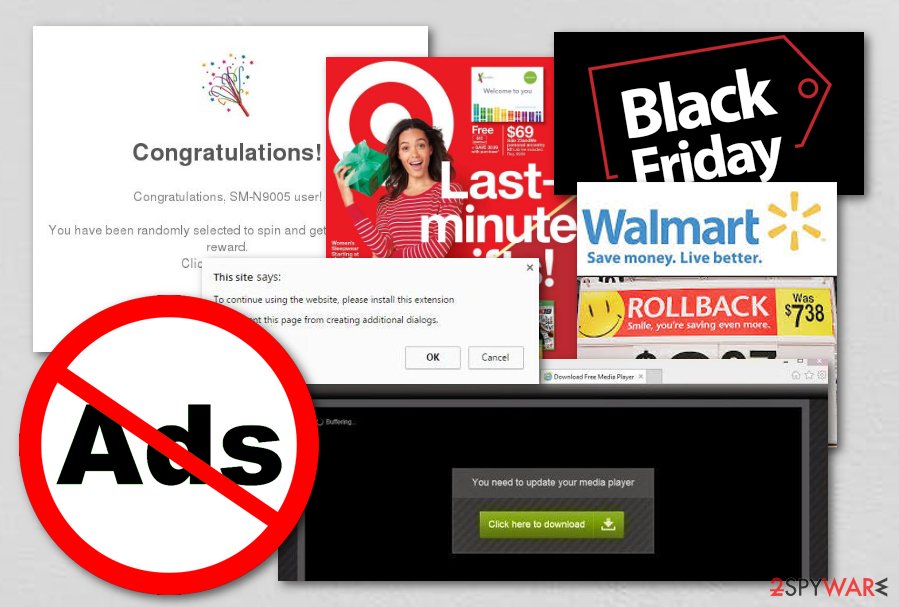S7.addthis.com (Removal Guide) - Aug 2019 update
s7.addthis.com Removal Guide
What is s7.addthis.com?
s7.addthis.com – a sign of an adware infection lurking in your browser

s7.addthis.com is a domain that is used by adware programs to redirect users to promotional websites. The aim of ad-supported applications is to display a big number of advertisements and collect pay-per-click revenue[1] through them. Additionally, these ads can initiate such activities as redirecting to affiliate sources which can be potentially dangerous in some cases. However, be aware that the name of s7.addthis.com virus is given for the app not for no reason as it spreads in software bundles[2] which allows getting into the system and hijacking web browsers unnoticed.
| Name | s7.addthis.com |
|---|---|
| Type | Adware |
| Category | PUP |
| Danger level | Low. Does not damage any system components |
| Aim | To collect pay-per-click income |
| Activities | Advertising, redirecting, browser modifying, collecting non-personal data, etc. |
| Spreading | The adware can be delivered in bundles of other software or met on suspicious networks |
| Cleaning | Try using FortectIntego for the discovery of dubious content |
There are several different types of activities that can be carried out by s7.addthis.com and other ad-supported programs. If you are not cautious enough while completing browsing actions and you let the adware into your system, be prepared to face some annoying changes. As soon as s7.addthis.com adware infiltrates the system it:
- might make changes to the system and alter Windows registry;
- hijack each of the affected web browsers that are installed on the targeted device;
- use a virtual layer to display different types of ads on each website you visit;
- open browser’s tabs and force users to visit affiliate websites;
- install third-party add-ons without asking permission;
- install publisher’s or third-party tracking cookies to collect browsing-related information.
s7.addthis.com is used for driving traffic to various websites that want to increase ranking in Google or other search engines. Additionally, adware’s activities might be used for increasing sales of specific products or services. However, clicking on the shopping deals or security alerts that might pop-up on the screen is not recommended. Commercial content is not always safe and sound, so you should be aware of potentially dangerous redirect tendencies.
The analysis of the adware shown that might be used by cybercriminals who are looking for new targets. For example, the installed adware program might start initiating redirects to questionable websites where malware-laden content is lurking and waiting to catch you. Hence, it’s better to remove s7.addthis.com as soon as you noticed suspicious activities on Chrome, Firefox or another web browser you use.

Additionally, the application which is responsible for redirecting to s7.addthis.com might also be capable of spying on you. Typically, these programs are collecting browsing-related information to deliver targeted ads[3] which are expected to receive more user’s clicks. When data about the user's recent searches and commonly visited pages are used for creating adverts, developers can get pay-per-click revenue.
Usually, developers who use adware and similar PUPs (potentially unwanted programs) for non-personal or even personal data (name, surname, email address) tracking inject cookies into the users' web browsers to succeed in their activities. So, if you want to know if a certain type of rogue program might be tracking you or initiating other suspicious activities, you should always check the website's Privacy Policy and Terms of Use.
However, your browsing sessions should not be diminished for money-making activities. That’s why you should opt for s7.addthis.com removal right now. You can use FortectIntego and get rid of the virus automatically or follow the manual removal guide below the article. Note that if you have been seeing advertisements from this domain only occasionally, you can try to prevent its repeated appearance by using AdBlock[4] or eliminating it from your browser settings:
- Open the browser that has been showing annoying adverts.
- Locate the menu which usually is the three dots in the upper right corner of the window.
- Launch Settings and go to the Advanced section.
- Look under Site Settings and you should find Notifications.
- Search for s7.addthis.com and block/remove it from the list.

“Unpacking” free software installers help to avoid unwanted apps
Developers of potentially unwanted programs (PUPs) are aware of the user’s weaknesses. Thus, they take advantage of the user’s bad habit to install free programs using Recommended/Standard settings. This setup does not disclose about optional components that might be included in the software package along with the primary program.
To avoid system hijack or similar PUPs, you have to rely on Advanced/Custom settings only. Additionally, you have to follow each of the steps attentively, to opt-out all agreements to replace your search provider or install questionable apps. If you complete every line as required, you can succeed in securing your computer and browsers.
Continuously, adware and other potentially unwanted content can infiltrate the system via other techniques, for example, third-party websites. Developers sometimes inject their software not only into bundles but also into secondary-downloading hyperlinks, banner ads, intrusive notifications, and similar locations. Keeping a proper distance from odd sources should help you to overrun PUPs.
Stopping s7.addthis.com virus and fixing the browsers
Manual s7.addthis.com removal requires a little of computer skills and patience. By following the guide below, you have to find and eliminate all adware-related components from the system and each of the affected web browsers. These guidelines are valid for all types of browser apps such as Google Chrome, Mozilla Firefox, Internet Explorer, Microsoft Edge, and Safari. Besides, you will be also provided with steps on how to get rid of the adware from both Mac and Windows OS.
Adware removal is not complicated. However, researchers from bedynet.ru[5] report that many users overlook some entries and fail to get rid of adware. So, if you doubt your skills in the malware removal field, it’s better to remove s7.addthis.com automatically with the help of anti-malware software. By the way, automatical antivirus programs are able to deal with the cyber threat in a couple of minutes when a person might take much longer.
You may remove virus damage with a help of FortectIntego. SpyHunter 5Combo Cleaner and Malwarebytes are recommended to detect potentially unwanted programs and viruses with all their files and registry entries that are related to them.
Getting rid of s7.addthis.com. Follow these steps
Uninstall from Windows
To remove s7.addthis.com redirect problem from Windows OS, follow these steps:
Instructions for Windows 10/8 machines:
- Enter Control Panel into Windows search box and hit Enter or click on the search result.
- Under Programs, select Uninstall a program.

- From the list, find the entry of the suspicious program.
- Right-click on the application and select Uninstall.
- If User Account Control shows up, click Yes.
- Wait till uninstallation process is complete and click OK.

If you are Windows 7/XP user, proceed with the following instructions:
- Click on Windows Start > Control Panel located on the right pane (if you are Windows XP user, click on Add/Remove Programs).
- In Control Panel, select Programs > Uninstall a program.

- Pick the unwanted application by clicking on it once.
- At the top, click Uninstall/Change.
- In the confirmation prompt, pick Yes.
- Click OK once the removal process is finished.
Delete from macOS
If you have spotted adware on your Mac OS X computer/laptop, you can get rid of it by completing the following:
Remove items from Applications folder:
- From the menu bar, select Go > Applications.
- In the Applications folder, look for all related entries.
- Click on the app and drag it to Trash (or right-click and pick Move to Trash)

To fully remove an unwanted app, you need to access Application Support, LaunchAgents, and LaunchDaemons folders and delete relevant files:
- Select Go > Go to Folder.
- Enter /Library/Application Support and click Go or press Enter.
- In the Application Support folder, look for any dubious entries and then delete them.
- Now enter /Library/LaunchAgents and /Library/LaunchDaemons folders the same way and terminate all the related .plist files.

Remove from Microsoft Edge
Clean Edge from any suspicious content that you have spotted:
Delete unwanted extensions from MS Edge:
- Select Menu (three horizontal dots at the top-right of the browser window) and pick Extensions.
- From the list, pick the extension and click on the Gear icon.
- Click on Uninstall at the bottom.

Clear cookies and other browser data:
- Click on the Menu (three horizontal dots at the top-right of the browser window) and select Privacy & security.
- Under Clear browsing data, pick Choose what to clear.
- Select everything (apart from passwords, although you might want to include Media licenses as well, if applicable) and click on Clear.

Restore new tab and homepage settings:
- Click the menu icon and choose Settings.
- Then find On startup section.
- Click Disable if you found any suspicious domain.
Reset MS Edge if the above steps did not work:
- Press on Ctrl + Shift + Esc to open Task Manager.
- Click on More details arrow at the bottom of the window.
- Select Details tab.
- Now scroll down and locate every entry with Microsoft Edge name in it. Right-click on each of them and select End Task to stop MS Edge from running.

If this solution failed to help you, you need to use an advanced Edge reset method. Note that you need to backup your data before proceeding.
- Find the following folder on your computer: C:\\Users\\%username%\\AppData\\Local\\Packages\\Microsoft.MicrosoftEdge_8wekyb3d8bbwe.
- Press Ctrl + A on your keyboard to select all folders.
- Right-click on them and pick Delete

- Now right-click on the Start button and pick Windows PowerShell (Admin).
- When the new window opens, copy and paste the following command, and then press Enter:
Get-AppXPackage -AllUsers -Name Microsoft.MicrosoftEdge | Foreach {Add-AppxPackage -DisableDevelopmentMode -Register “$($_.InstallLocation)\\AppXManifest.xml” -Verbose

Instructions for Chromium-based Edge
Delete extensions from MS Edge (Chromium):
- Open Edge and click select Settings > Extensions.
- Delete unwanted extensions by clicking Remove.

Clear cache and site data:
- Click on Menu and go to Settings.
- Select Privacy, search and services.
- Under Clear browsing data, pick Choose what to clear.
- Under Time range, pick All time.
- Select Clear now.

Reset Chromium-based MS Edge:
- Click on Menu and select Settings.
- On the left side, pick Reset settings.
- Select Restore settings to their default values.
- Confirm with Reset.

Remove from Mozilla Firefox (FF)
Follow these steps to get rid of s7.addthis.com ads and redirects:
Remove dangerous extensions:
- Open Mozilla Firefox browser and click on the Menu (three horizontal lines at the top-right of the window).
- Select Add-ons.
- In here, select unwanted plugin and click Remove.

Reset the homepage:
- Click three horizontal lines at the top right corner to open the menu.
- Choose Options.
- Under Home options, enter your preferred site that will open every time you newly open the Mozilla Firefox.
Clear cookies and site data:
- Click Menu and pick Settings.
- Go to Privacy & Security section.
- Scroll down to locate Cookies and Site Data.
- Click on Clear Data…
- Select Cookies and Site Data, as well as Cached Web Content and press Clear.

Reset Mozilla Firefox
If clearing the browser as explained above did not help, reset Mozilla Firefox:
- Open Mozilla Firefox browser and click the Menu.
- Go to Help and then choose Troubleshooting Information.

- Under Give Firefox a tune up section, click on Refresh Firefox…
- Once the pop-up shows up, confirm the action by pressing on Refresh Firefox.

Remove from Google Chrome
These guidelines will help you to stop unwanted activities on Google Chrome:
Delete malicious extensions from Google Chrome:
- Open Google Chrome, click on the Menu (three vertical dots at the top-right corner) and select More tools > Extensions.
- In the newly opened window, you will see all the installed extensions. Uninstall all the suspicious plugins that might be related to the unwanted program by clicking Remove.

Clear cache and web data from Chrome:
- Click on Menu and pick Settings.
- Under Privacy and security, select Clear browsing data.
- Select Browsing history, Cookies and other site data, as well as Cached images and files.
- Click Clear data.

Change your homepage:
- Click menu and choose Settings.
- Look for a suspicious site in the On startup section.
- Click on Open a specific or set of pages and click on three dots to find the Remove option.
Reset Google Chrome:
If the previous methods did not help you, reset Google Chrome to eliminate all the unwanted components:
- Click on Menu and select Settings.
- In the Settings, scroll down and click Advanced.
- Scroll down and locate Reset and clean up section.
- Now click Restore settings to their original defaults.
- Confirm with Reset settings.

Delete from Safari
Follow this guide to clean, refresh, and optimize Safar after the hijack:
Remove unwanted extensions from Safari:
- Click Safari > Preferences…
- In the new window, pick Extensions.
- Select the unwanted extension and select Uninstall.

Clear cookies and other website data from Safari:
- Click Safari > Clear History…
- From the drop-down menu under Clear, pick all history.
- Confirm with Clear History.

Reset Safari if the above-mentioned steps did not help you:
- Click Safari > Preferences…
- Go to Advanced tab.
- Tick the Show Develop menu in menu bar.
- From the menu bar, click Develop, and then select Empty Caches.

After uninstalling this potentially unwanted program (PUP) and fixing each of your web browsers, we recommend you to scan your PC system with a reputable anti-spyware. This will help you to get rid of s7.addthis.com registry traces and will also identify related parasites or possible malware infections on your computer. For that you can use our top-rated malware remover: FortectIntego, SpyHunter 5Combo Cleaner or Malwarebytes.
How to prevent from getting adware
Do not let government spy on you
The government has many issues in regards to tracking users' data and spying on citizens, so you should take this into consideration and learn more about shady information gathering practices. Avoid any unwanted government tracking or spying by going totally anonymous on the internet.
You can choose a different location when you go online and access any material you want without particular content restrictions. You can easily enjoy internet connection without any risks of being hacked by using Private Internet Access VPN.
Control the information that can be accessed by government any other unwanted party and surf online without being spied on. Even if you are not involved in illegal activities or trust your selection of services, platforms, be suspicious for your own security and take precautionary measures by using the VPN service.
Backup files for the later use, in case of the malware attack
Computer users can suffer from data losses due to cyber infections or their own faulty doings. Ransomware can encrypt and hold files hostage, while unforeseen power cuts might cause a loss of important documents. If you have proper up-to-date backups, you can easily recover after such an incident and get back to work. It is also equally important to update backups on a regular basis so that the newest information remains intact – you can set this process to be performed automatically.
When you have the previous version of every important document or project you can avoid frustration and breakdowns. It comes in handy when malware strikes out of nowhere. Use Data Recovery Pro for the data restoration process.
- ^ What is pay per click?. Quora.com. Relevant questions and answers.
- ^ Bundled software. Webopedia. An online dictionary and Internet search engine for information technology and computing definitions.
- ^ Margaret Rouse. Targeted ad (targeted advertising). TechTarget. Technology definitions.
- ^ Ad Blocker. Techopedia. Tech terms and definitions.
- ^ Bedynet. Bedynet. Cyber security news.























